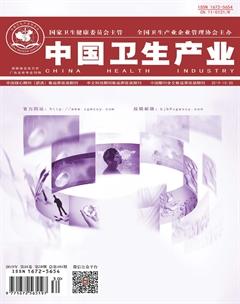基于临床路径的护理管理方案对胸外科护理质量的影响
彭姝芳
[摘要] 目的 探讨基于临床路径的护理管理方案对胸外科护理质量的影响。方法 选取2013年1月—2014年12月该院未实施基于临床路径的护理管理方案时的护理管理事件130例作为对照组,另选取2015年1月—2016年12月该院实施基于临床路径的护理管理方案时的护理管理事件130例作为观察组,对比分析两组的护理工作质量。结果 干预后,观察组护理工作质量评分,明显高于对照组,差异有统计学意义(P<0.05)。结论 在胸外科护理中,有效实施基于临床路径的护理管理方案,效果显著,可极大提升胸外科护理工作质量。
[关键词] 临床路径;护理管理;胸外科;护理质量
[中图分类号] R473 [文献标识码] A [文章编号] 1672-5654(2019)10(c)-0099-02
Effect of Nursing Management Program Based on Clinical Pathway on Nursing Quality of Thoracic Surgery
PENG Shu-fang
Department of Thoracic and Cardiovascular Surgery, Changchun Central Hospital, Changchun, Jilin Province, 130051 China
[Abstract] Objective To investigate the effect of nursing management program based on clinical pathway on the quality of nursing in thoracic surgery. Methods From January 2013 to December 2014, 130 cases of nursing management events in our hospital without clinical pathway-based nursing management program were selected as the control group. The other patients were selected based on the clinical path from January 2015 to December 2016. In the nursing management program, 130 cases of nursing management events were used as the observation group to compare and analyze the quality of nursing work in the two groups. Results After the intervention, the quality of nursing work in the observation group was significantly higher than that in the control group and the difference were statistically significant (P<0.05). Conclusion In the nursing of thoracic surgery, the effective implementation of the nursing management program based on the clinical path has a significant effect, which can greatly improve the quality of nursing work in thoracic surgery. It is worth promoting.
[Key words] Clinical pathway; Nursing management; Thoracic surgery; Quality of care
在护理管理工作中,主要包含两方面内容,即护理质量、护理安全。当前,大多数医院管理人员选择改进护理管理方案,来不断提升医院的护理工作质量。胸外科作为一个重要科室,大都收治一些病情较为复杂的患者,且急需手术治疗,因而面临着较大的护理风险,为了提升护理质量,需加强对护理安全的管理[1-2]。基于此,该文提出了基于临床路径的护理方案,并就其于2015年1月—2016年12月在胸外科护理工作中的具体应用进行了分析,报道如下。
1 资料与方法
1.1 一般资料
选取260例该院胸外科护理管理事件,根据实施基于临床路径的护理管理方案的时间点,将其分为对照组(2013年1月—2014年12月)130例,观察组(2015年1月—2016年12月)130例。两组的护士人员基本资料差异无统计学意义(P>0.05)。
1.2 方法
创建管理小组。护士长为组长,组成成员为4~5名有经验的胸外科护士。由管理小组负责制定护理管理方案,并监督实施情况。由护士长带领管理小组学习临床路径相关知识,并借助工作调研、查阅文献资料等方式,拟定关于胸外科常见疾病的临床护理方案。依据临床路径思想,處理少见疾病类型及突发事件,制定应急方案,依据患者病情变化,随时调整护理方案。拟定临床护理路径后,需带领护理人员试行,解决试行中存在的问题,并确认可行后将其归入医院管理制度。组织培训。对全科护士展开培训,使其具有临床路径工作理念,并依据循证观点,严格执行基于临床护理路径的护理工作。其次介绍常见病种的临床护理路径表,告知护士护理工作要点、注意事项及管理制度变更情况。实施与质量控制工作。依据不同的临床护理路径,护理患病患者,告知其临床护理路径表内容及价值,并酌情调整。达成一致后,据此展开护理工作,并实时标注执行情况。此外,管理小组还需加强质量控制工作,监督护士工作情况,并收集患者反馈,由管理层面随时解决护士工作中的不足之处。

